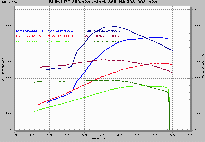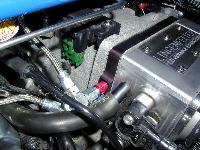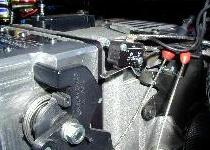My winter '99 car project was adding a custom nitrous oxide system to the car. I worked slowly, doing all the parts custom myself. It's quite an experience, fiddling with plumbing, making brackets, and figuring out the wiring, let alone learning how this stuff will work.
If you're new to nitrous systems, I've written up a "New to Nitrous" Guide to help you understand the terms and basic setup.
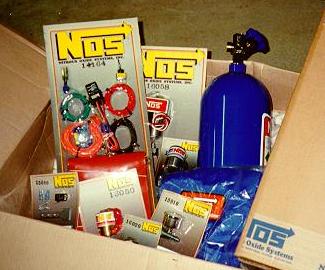 |
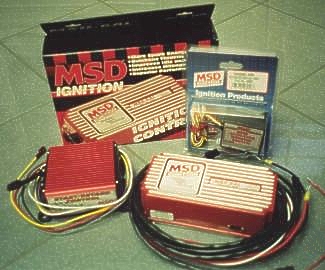 |
Oh boy, Christmas in February! Most of the nitrous components will be from NOS, and ignition (MSD-6420 with MSD #8877 LT1 ignition harness and MSD #8982 timing retard box from MSD, though all of the fittings and hoses I picked up locally. This will be a wet "fogger" system, so I'll have three solenoids, and auxiliary fuel pump, requisite bottle setup in the trunk, and all the switches and stuff.
Testing...
June 1, 1999: I've started testing the system at the track, finally. It's like starting all over again. Using a completely custom setup has left me to figure out the appropriate jetting setup, as well as generally debugging the system (and the driver!). I've had a few good parts of passes, but haven't made a complete strong nitrous pass yet, and probably won't until after the rear is installed and the nitrous tested on the dyno. The best timeslip so far is posted at the top of this page, and I've had a best mph of 118.223, running a 0.055" nitrous jet and a 0.035 fuel jet. I'm having big-time traction problems in second gear, possibly because I refuse to lower the tire pressure below 14psi, for fear of breaking.
July 31, 1999: I spent the morning with the car on a dyno, to come up with some fuel and nitrous jets that performed well, and within safety margins. We first ran the motor baseline you see below. Then we ran a series of jets, starting with the 0.055" N2O/0.035" fuel I'd used a couple times at the track, which showed a 80hp gain, and were running quite rich. We ended up with a 0.067" N2O jet and a 0.035" fuel jet, showing the curve you see below. It's a nice 152hp and 195ft-lbs gain at the rear wheels.
August 7, 1999: Headed down to the track with high expectations, but they didn't pan out. As soon as the nitrous kicked in at 3000rpm, the clutch immediately slipped, and just couldn't hang on. Sorry RPS, you were as good as you claimed, but 600hp killed you. I made a couple passes with smoke pouring out from under the car, and ended up with a best of 12.756@120.583. So there's some power there, but I need a new clutch. Called McLeod and ordered the Street Twin the next day.
September 17, 1999: I met my buddy Kyan last night at Sacto, for the big test of the nitrous setup, new McLeod clutch, 12-bolt, etc, etc. It was really the first time I could legitimately expect the car to hold together under the new power, and I was pretty anxious to get in a good pass or two.
Since there is a big race today, it turned out that today's racers were all out there last night. Plenty of rails, a jet (now that was cool), a funny car, generally lots of fast cars. Not a single car that looked newer than 1972.
Except me ;-)
After a couple non-interesting passes, and quite a bit of frustration in the staging lanes (they were doing some of the weirdest stuff I've seen down there), I made it to the front for my last pass. Oh, they had put all the .5 tree guys in one lane, and let the pro tree guys have the other six lanes. So I'm off in this weird lane. At the end of the evening, Lonnie started running cars head's up, but instead of just taking the first two cars from the .5 lane, they'd take one from there, and seemingly grab someone at random from another lane (whoever was ready, it seems to take those guys forever to get cars going). They'd have a chat with that guy (this is Lonnie here), presumably asking him "are you willing to let us run this bozo in the opposite lane from you, and what tree do you want to use?" I noticed the tree was running in either mode, .5 one race, pro the next. Weird.
Okay, on with it. I get lined up to a pro stock 1st generation Camaro, with XXXX Racing on the side, covered with stickers, big mongo slicks, of course, wheelie bars, the works. Uh oh.... We stage up (I do the professional thing with the lights :-). I remembered all 18 steps to getting the nitrous prepared. Of course, I have no idea what tree we're using, but I'm ready. Lights tick down - boom all yellows go on, I launch like a banshee - 0.507 YES! He's on my right, and through my window, I see his front tire in the air, but while he's up there floating, I manage to scoot forward to a best-ever 1.69 60', on the juice already. Through 1,2,3 gears, we're neck and neck, with me pulling ahead of him, and at half track, I'm at least a car ahead. It was a great race. At about the 1/8 (7.65@92), he starts gaining on me. Whoops - I thought these guys were supposed to be bricks, and lose out on the top end?? Maybe he hit the bottle? At the end, it was too close to call from the car, but as I came back to the staging lanes, I could see it in Kyan's grin. I got a 11.757@122 to his 11.78@128.
I'm pretty thrilled about the race, it was just awesome. The guy drove straight from the return road off to his trailer :-) so I didn't get a chance to chat with him. I'm sure he didn't want to anyway.
I'm a little surprised I wasn't going faster, though. There's quite a bit of off-on-off-on from the nitrous as I go through the gears, and that's definitely slowing me down. I'll have to figure out if there's a way around that one.
Solenoid Failure!
December 11, 1999, Thunderhill Street School (okay, let me step back just a minute here. Yes, Thunderhill is a road course, and yes, I was running nitrous on the main straight. It was a blast to try, but in retrospect, as you're about to read, a real mistake). The nitrous solenoid stuck open after a pass down the front straight, and I ran about ½ a bottle of nitrous through the motor without fuel. Talked to NOS on 12/16/99 about this, of course there’s no warranty. Their thoughts: The only way a solenoid would stick in the open position is if something was stuck in there. Not only does the spring push down against the opening, but it’s setup such that the pressure from the nitrous line also pushes the solenoid closed. It takes quite a bit of power to actually open the solenoid. I also think that perhaps the heat in the engine bay from driving hard on the road course, combined with the longer-than-normal holding of the solenoid open may have heated it up enough so that it stuck open due to metal expansion. Bottom line, I really don't know why this happened.
Suggested changes: I should put the filter up by the solenoids (I had it at the bottle), maybe something from inside the hose stuck in there. I could also wire the solenoids on connectors so I can check them easily. Also might disassemble them periodically for a checkout. Can also test the strength of the solenoid – it should have 1.2 ohms across the coil, and draw 10 amps. If it’s outside these values by more than 10%, replace the solenoid. The best answer seems to be to run two nitrous solenoids serially, and test them before every event. Oh, and don't run nitrous on a road course.
This was quite a scary incident. As well as the solenoid, I blew out a catalytic converter, at least one O2 sensor, and I'm still putting the car back together (Jan '00). It's been on the dyno and had a compression test, and the motor looks fine. I suspect, though, that if I'd had a stock motor, it would be history.
Stock 350, NA 383 and Nitrous
Dyno Curves
(click for detail)

Here are the solenoids (purge - NOS-16020, nitrous - NOS-16000, and fuel - NOS-16050, left to right) mounted under the Hotchkis strut tower brace. While this is an extremely tight fit, it puts the solenoids just inches away from the throttle plate, which is good. It also gets most of the setup under the engine bay without grabbing much valuable space. My fuel setup is a bit different from stock. On a stock fuel rail, you normally connect the fuel solenoid to the schrader valve at the rear of the rails. You'll need to unscrew the center of the valve (get a "core removal" tool from an auto shop), then use a swiveling -4AN fitting on the fuel line to connect to the schrader. You'll probably also want a "T" in it, so you can attach the FPSS as well. Be careful when tightening things down on the schrader, it's a pretty weak fitting.
At left is the NOS-13420 fogger plate, installed behind the throttle body. You can see the fuel and nitrous connections coming in from the solenoids. Installation was really a pain, because the LPE/Accel 58mm throttle body is already a half-inch deeper than stock, and with the additional half inch for the plate, everything ran right in to the water pump. I spent hours carefully dremelling away at the pump and IAC until it fit. In addition, my cruise control cable is now too short to fit. In retrospect, I should have bought a different brand throttle body, in stock size, as it seems like it would drop right in.
At center are the jets you use to meter fuel in nitrous into the throttle body. You select the right size (size of the hole in the jet, measured in thousandths of an inch), and insert the jet in the connection to the throttle plate. Larger jets allow more nitrous and fuel, thus higher horsepower.
At right is a shot of the NOS-15640 throttle microswitch, which is one of the triggers for opening the nitrous and fuel solenoids. As the throttle body valves are opened, the bracket hits this switch right at full throttle, triggering the signal to the rest of the system.
I installed it at the rear of the throttle bracket - it seems to fit much more nicely here, rather than the front where most folks have it.
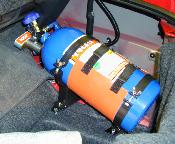 |
Nitrous bottle, mounted in the trunk. It's got a NOS-16058 remote opener installed, so I can open it from inside the car. I'm also using the NOS-14164 bottle heater. |
 |
MSD #8956 RPM Window Switch, to control the nitrous system such that it only functions within a certain RPM range. I'm using 3000-6200 RPM (rev limit is at 6400). For the full wiring diagram, click here. |
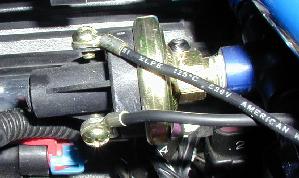 |
The gizmo to the right is a NOS-15685 Hobbs fuel pressure safety switch, which is used to verify that adequate fuel pressure exists to run the nitrous system. It's plumbed into the fuel line, before the solenoid, and provides a complete circuit through the two wires if fuel pressure exists, and breaks the circuit if pressure drops. It's used to cut off the nitrous system if fuel pressure falls. For the full wiring diagram, click here. |
 Here's a shot of some of the switches to run the system. There's
a master nitrous switch, and a bottle heater switch above three lights (bottle open/close,
heater on). Behind the shifter are my line lock and purge button. Most of these switches
and lights came from Radio Shack, which had the
best selection I could find. For the full wiring diagram, click here.
Here's a shot of some of the switches to run the system. There's
a master nitrous switch, and a bottle heater switch above three lights (bottle open/close,
heater on). Behind the shifter are my line lock and purge button. Most of these switches
and lights came from Radio Shack, which had the
best selection I could find. For the full wiring diagram, click here.
For additional information on nitrous use, I recommend:
"How to Install and Use Nitrous Oxide", Joe
Pettitt, S-A Design Series, Cartech Books, ISBN 1-884089-22-4
"The Complete Do-it-yourself Guide to Nitrous-Oxide
Injection", David Vizard, S-A Design Series, ISBN 0-931472-16-4
The Nitrous Oxide Information Site: http://www.5150.org/nitrous/
My own New to Nitrous
overview
|
Copyright © 1997-2004 David Mills, no part of this site (http://www.go-fast.org/) may be reproduced without permission of the author. The author makes no claims or guarantees as to the quality of the information on this site. I'm an enthusiast just like you, and while everything here is correct as I know it, I'm not responsible if your car breaks. |














